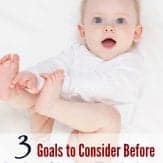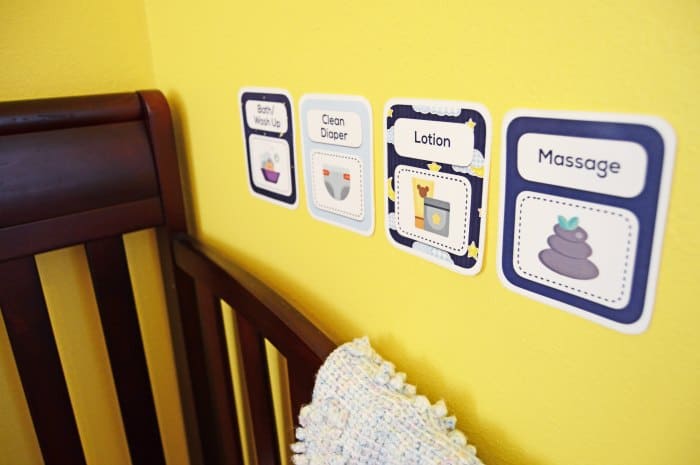Sometimes baby sleep training gets a bad rap. There are countless misconceptions about what baby sleep training really involves, and readers frequently are ask questions about first steps to take and overall sleep goals for baby. I relate so much to that feeling…
How do you know which baby sleep tips are best for healthy sleep habits?
How do you know what you should or shouldn’t do?
Well friends…there isn’t a clear cut answer here. I wish there were. But there are several goals we prioritized when helping our son sleep better. Goals that can really make all the difference in the world when it comes to sleep.
post contains affiliate links
So today I wanted to talk a little bit about what baby sleep training really means, along with a few realistic long term goals to help your baby sleep better in the long run. I say long run because guiding and teaching a child takes time and diligence. It’s okay if things don’t automatically fall into place. I promise. So long as you keep gentle, responsible and safe methods in mind, you will start to see improvements overtime.
Always remember, the foundation you lay in the early months will have a dramatic effect on sleep in the years to come.
So what does baby sleep training really mean anyway?
I remember when we first started on our new adventure as parents. I felt so lost as a new mom. I wanted everything to go well, and my son was far from ‘by the book.’ Looking back now, it’s easy for me to realize that I really needed to let things go. To allow things to fall into place overtime and not count and compare the success and failures.
So…
For most families, sleep training is teaching your child to fall asleep independently in a way that makes you and your child feel comfortable. This can be accomplished in many gentle ways without using extremes.
It means helping your baby get very sleepy and laying him down awake if possible. It means offering comfort and additional soothing and TLC when your baby needs it. It also means offering your baby the opportunity to do things on their own when he can. Babies were born to sleep. It’s natural to all species. So when you allow your baby to fuss for a short period of time before falling asleep—that is teaching independent sleep.
Baby sleep training shouldn’t be confused with laying your baby down to cry themselves to sleep only to return in the morning. Far from it actually. Teaching independent sleep means allowing your baby the opportunity to learn to fall asleep alone, helping him along when needed, and returning to the baby after he wakes.
When your baby wakes up or if he cannot fall asleep, go to your baby. Nurture him. Love him. And help him along if he truly needs it. The ultimate goal is to guide your baby towards independent sleep over a period of months.
3 Important Baby Sleep Training Goals to Consider
1. Baby sleeps when it’s time to sleep.
This means starting your baby on an approximate schedule when you feel the time is right. We started at 6 weeks and still follow an approximate schedule over 18 months later. There is no need to start a schedule until a baby is a minimum of 4 weeks old. After the initial newborn month, feel confident starting an approximate schedule if you think your baby will tolerate it.
Implementing a successful sleep schedule and routine is a major component when developing a sleep plan. Quality sleep schedules and routines incorporate several vital components:
- Consistently following a flexible schedule.
- Wind down time in which activities before sleep are low key.
- Dim the room by turning off lights and closing the curtains
- Get your child into comfortable attire, which could include a clean diaper, pajamas and a wearable blanket or swaddle.
- Settle your child to a calm and sleepy state of mind.
- Say a sleepy phrase (for example, “I love you. I hope you have a good sleep. I will see you when you wake up.”)
- Lay your child down for sleep.
Those are the general basics to keep in mind when creating a newborn routine or baby routine. Beyond these basic components, you can use your creativity to tailor a sleep routine to your child’s needs.
One simple thing you can do to help your baby wind down for sleep is to use a set of routine cards like these.
Once the baby is on a schedule for a few weeks, the best goal is to have the baby sleep when you want. This means that they baby regularly sleeps according to the approximate schedule. Be flexible of course, but overall be consistent with sleeping times. When you are working on this first goal, the baby can still be rocked to sleep or sleep in places besides a crib.
Simply try to keep the baby on a good schedule.
2. Baby sleeps when it’s time to sleep and where you want.
The next step here is to keep the baby on the schedule and get the baby to sleep in their own room in a crib. The ultimate goal is to help the baby get used to his room and surroundings, and avoid the use of the sleep props if possible.
So if you are using a swing, bouncer, pacifier, rock ‘n play, and beyond, simply try to minimize the use. You don’t have to give it up altogether. Simply try to use it only when you need to—perhaps only 2 times a day. Then only 1 time per day. Until you eliminate it completely.
3. Baby sleeps when it’s time, where you want, and he falls asleep on his own.
This is what most would call baby sleep training. I prefer to call it, teaching independent sleep since sleep training often comes across as rigid and extreme. Teaching independent sleep is guiding your child towards sleep via approximate schedules, routines, consistency, and finally laying your child down awake but drowsy.
For some babies this works very well; for others, it doesn’t. Don’t stress. Truly. Don’t stress.
If it isn’t going well, feel confident reverting back to the previous goal and try again at a later time. Simply keep a good schedule and try your best to have baby sleep in the crib. Those are TWO great accomplishments on their own!
If independent sleep doesn’t happen right away that’s okay. All babies are different and sleeping independently takes time. Don’t feel discouraged that you aren’t doing it correctly. You are doing an amazing job. Listen to your baby and your gut. Things often start to fall into place when you least expect it.
Print your free baby sleep checklist!
This post comes with a free printable baby sleep checklist to help you support longer stretches of sleep for your baby! Plus, when you grab this printable, you’ll get instant access to my free 3-day baby sleep eCourse.
Download Your Free Printable
- Download the checklist. You’ll get the printable straight to your inbox, plus get my Free 3-Day Baby Sleep eCourse!
- Print. Any paper will do the trick, but card stock would be ideal.
- Place it on your refrigerator. Use it as a quick reference and don’t forget a thing!
Want more on baby sleep?
- My Top 10 Newborn Baby Sleep Tips To Help You Get More Sleep
- The Newborn Routine That Will Help Your Baby Fall Asleep Faster
- Top 7 Challenges + Solutions for Parenting a Newborn and Toddler
- 8 Infant Sleep Facts Every Parent Should Know
Resources for baby sleep:
I've created a free email series just for you! If you are struggling with finding a routine, rhythm or schedule, this email series will help you find one that will work for YOUR family. Yes, really. I've seen my sample routines work time and time again for parents. I know it can work for you too.
This free email series will help you:
- Free sample routines for your child
- Best morning routine tips and tricks your kids will actually follow
- All-time favorite parenting hacks for getting more cooperation at bedtime
- Step-by-step guide for using a printable daily schedule with kids














Hi. Thanks so much for your insights! My son is on a 3 hour schedule and we are starting to introduce this method. What’s your advice if he doesn’t fall asleep in time for his next feeding? Also is there a better time to start laying them down on their own to sleep, night time or nap time?
If he doesn’t sleep between feedings that is okay. Simply go ahead and feed him at his next feeding. If he is still asleep at his next feeding time and has been sleeping for more than an hour, I may go ahead and wake him up. The goal is to create a pattern over time inching your way to a desired schedule. So go ahead and make small adjustments trying to get where you need to be. Schedules aren’t perfect and they are completely flexible so find what works for you and your baby and feel confident with that. If you want to start laying him down for sleep on his own, I always aimed for about 80%. We started with night time, but transitioned to naps in the same exact week. Consistency is very important. So in my opinion a baby doesn’t differentiate between being held for a nap and not during the night…they simply see it as sleep time. So in order to avoid confusion, we aimed to have our son fall asleep on his own about 80% of the time. Of course life happens and we are running errands and what not and he will sleep in the car or in our arms from time to time and that is totally understandable. Hope that helps!
Do you have any tips for those of us that need to share a bedroom or studio apartment with our baby? Is it possible to achieve independent sleep that way?
Hey Jessica,
I haven’t tried it, but I found myself in that type of situation, I would get a small room divider. Do you know what I mean? It’s a tri-fold type screen or divider that could keep you out of sight from the baby. I would also try to keep the baby’s bedtime at a time that you are able to turn down the lights and have quiet time with your spouse. Feel free to email me if you’d like to chat more or have more questions! Not sure if this helps?
Lauren
Hi Lauren, I appreciate your article. Thanks for passing on the knowledge – very helpful for us families with little ones. We’ve got an almost 1 yr old daughter that we’ve started sleep training and she’s been making steady improvements – which has been fun to see. I wish we had started sooner but it is what it is (you don’t know what you don’t know).
I have a question for you but want to lay out some context first.
Our routine is to dim lighting, change diaper, get her into PJ’s and walk around the house. I take her around the house and have her say “goodnight” to the house in the same order each time. We then give her a bottle of warm milk and lay her in bed. She’s usually feeling sleepy by this point. She’ll finish the bottle and then she’ll stand up and come to the end of the crib and yell for us. We’ll gently kiss her on the head, say “it’s time for bed sweetie” and lay her back down. But it becomes a cycle and she keeps standing back up for more.
Inevitably, she gets tired and so do we, and we rock her to sleep in one of our arms. From start to finish, it’s taking around an hour.
My question is what adjustments would you recommend we try making? It feels neglectful if we let her cry it out, but then again we also want to find a way where we can gently be laying her down at the end of our routine and she independently falls asleep.
Any input would be greatly appreciated, thanks Lauren! Keep up the good work!
Nick
Nick, if it feels neglectful when she cries, then you should follow your gut. Your parenting instincts are there for a reason 🙂 You can continue to lay her back down and sit in the room – perhaps on the floor next to her. Try it without talking, but simple offering a presence for her. The most challenging part with sleep – if you want to give up rocking her to sleep – is that you’re going to have to give it 1-3 weeks of staying in the room and allowing her to fall asleep without rocking. It’s 100% up to you. There is certainly nothing wrong with rocking if you’re OK with it. If you want to make a change, and it’s a REAL boundary for you, then you can start to move forward with a change. If the crying isn’t OK with you, and you’ll stretch or move your boundary around, it’s a clear signal that it’s not a real boundary for you. Parenting isn’t filled with right and wrong answers, but rather checking in with yourself and deciding what you’re OK with and not OK with. And then honoring it.